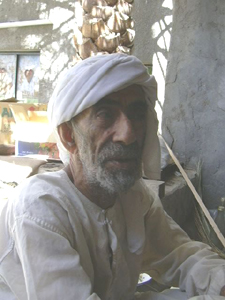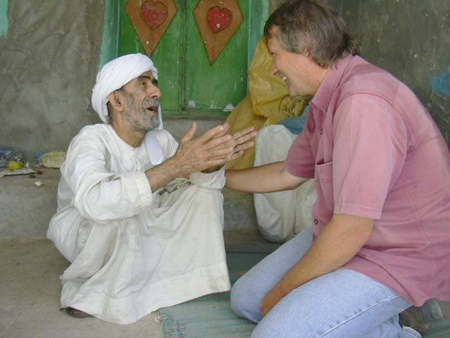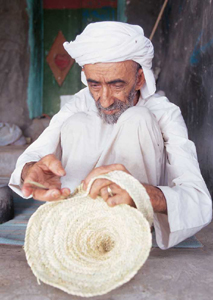|
Under
the Patronage of H.E. Sheikh Nahayan Mubarak Al Nahayan
|
|
The ENHG
Al Ain Chapter
Newsletter
|
|
|
The
Emirates Natural History Group, Al Ain Chapter, PO Box
18057, Al Ain
January, 2006– Issue #232 |
|
A
Spring Flowering of Date Palms
Notes inspired by Phoenix dactyliflora
on a walk through Khudrah oasis. |
Article
& photos by Marion Campey |
| My
top will be green until day eternal.
And those persons who lack bread and wine
Eat fruit from me until they become filled
Draxt 1 Asurig
|
| Date palms are dioecious,
meaning there are separate male and female plants. Their
respective flowers are carried in bunches at the top of
the tree. Each male tree produces sufficient pollen to
fertilise up to fifty trees hence the ratio of 1 male
to 25-50 female palms in oases.
On the walk through Khudrah, we noticed that the long
stems of creamy yellow female flowers (inflorescence)
had burst out of the brown sheaths (spathes) that protected
their early development.
They shoot up expectantly, and for a short period of
7 days, present a window of opportunity for fertilization
from the male flowers. The date farmers do not let this
chance pass by. The normal practice is to introduce
bundles of the male inflorescence in the spadix of the
female tree so that the male pollen can fertilise the
female flower. This manual pollination is the norm and
ensures a decent crop of dates. A single bunch (spathe)
may contain up to a thousand dates with each palm producing
an average of twelve bunches.
|

A stem of male flower (the
pale stem at the bottom right)
has been introduced into the female florescence.
( Khudra Oasis) |
|
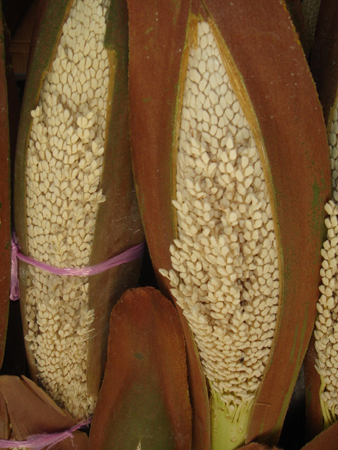 Male inflorescence in spathes for sale
at Al Ain souq
Male inflorescence in spathes for sale
at Al Ain souq |
|
|
|
| This broadsheet is published free to families in
the Al Ain area. If you are a member planning an activity with a natural
history theme please notify us so that others can join you. Everybody
is able to contribute to ENHG and Emirates recordings. For more on
our activities please visit our website <www.enhg.org> or join
our e-mail discussion group at ENHG@Yahoogroups.com. The Group meets
at 7.30pm on the 2nd & 4th Tuesday of the month, usually at the
Intercontinental Hotel. New Members are welcome. |
|
---------------------------------------------------------------------------------------------------------------------------------
| The ENHG
Al Ain Chapter Newsletter…
February, 2006– Issue #232 |
A
visit to Khudra oasis. |
Friday 17th
February. |
| We set out on our walk at the wadi
crossing, leaving behind the cluster of white, flat roofed housing
that is the “new” village and bringing with us that
delicious sense of anticipation, of leaving the rest of the
world behind. What will we discover this time?
The wadi curves around, wide and shallow from west to east
where the gravel plain stretches out a little only to be gathered
up and hemmed in by the spines of the Hajar Mountains. The
wadi, plain and mountains form the natural limit to the oasis.
We choose not to enter the oasis at the crossing instead
heading off to our left, along the curve of wadi, hopping
over the smooth bedrock and pools that harbour polliwogs (tadpoles),
waterskaters and the small Arabian toads. The different toad
species can be identified by the distance between the eye and
ear though not one of us attempts this exacting exercise. A
dragonfly hovered dipping its rear in the water as it
deposited eggs – the action of a determined ovipositor in spite
of the large audience. On the northern side sedges and bulrushes
grow and further along, donkey’s cabbage and euphorbia
are noted. To our right, on the southern side of the wadi,
conglomerate cliffs rise up to the oasis edge, forming a steep
and water worn natural limit to the oasis. It is in these
cliffs that maidenhair and wild orchid flourish, nourished
by water seepage and sheltered from the hot sun. The seepage
is heavily charged with fertilizer nutrients from the oasis
garden causing algal growth in the lower stagnant pools. |
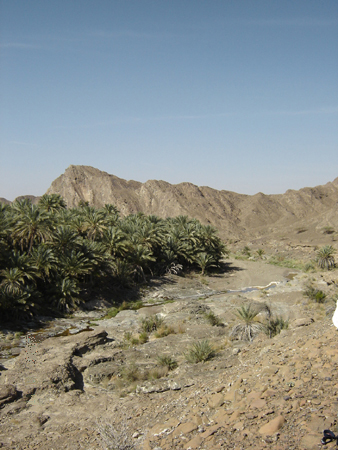
The wadi curves around, wide and shallow |
|
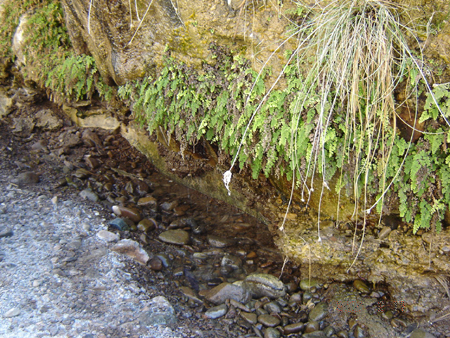 Maidenhair and wild orchid flourish
photos by R. Falconer
Maidenhair and wild orchid flourish
photos by R. Falconer |
|
| We glimpse a worker clambering up
a date palm, using a sheath to haul himself over the spines
to reach the top where the pale creamy flowers have burst out
of the protective spathe. It is time for manual pollination
and thus securing a bountiful date crop.
We keep a sharp eye out for water scorpions, of interest
because their handy breathing tube which is suspended on the
surface of the water though disappointingly none are spied.
Water flows, trickling softly and further on, we find in one
of the stagnant pools the discarded skin identified as that
of a small freshwater cray.
|
|
|
----------------------------------------------------------------------------------------------------------------------------
| The ENHG
Al Ain Chapter Newsletter…
February, 2006– Issue #232 |
A
visit to Khudra oasis cont...
|
The wadi is left behind, as we
scramble up onto the gravel plain, the oasis framed to the
south by the jagged mountain range against which the date
palms, mango trees and minaret form a memorable profile. The
group, led by Brien, focuses on a small circular area of cleared
plain. It’s majlis seating area, created knowingly on
a bit of prime real estate with “views forever”!
We find out that another kind of cleared shallow depression
with a clay surface have been created for the use of watering
donkeys. The archaeology extends over the next several hundred
metres to include a school, the remains of housing, a cemetery,
mosque, terraces and small weirs. It is noted that in an Islamic
grave, the body, i.e. face, fingers and feet, is oriented
towards the west (Mekkah) even though the grave’s alignment
is north/south. It is polite not to walk on the graves and
also to acknowledge, through a simple prayer, the presence
of deceased persons. |
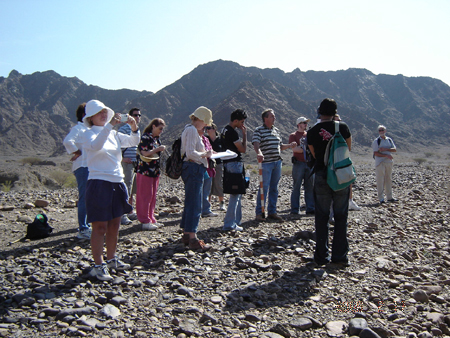 The group, led by Brien, focuses on a small
circular area of cleared plain
photo by R. Falconer
The group, led by Brien, focuses on a small
circular area of cleared plain
photo by R. Falconer |
We clamber back down into and
across the wadi to enter the oasis at the eastern end, skirting
the “old” and still inhabited village where children
play and call out “how are you?” the generic and
well meant greeting that is used instead of “hullo”.
Cow and goats are penned, aloe vera, cactus, grow in clusters.
A small open-sided mosque has an Arabic inscription painted
on one wall, which roughly translated means “mistakes
will be forgiven as Allah has a big heart”. Thus fortified
by such generous words, we continue on admiring fruiting figs
and nabj, flowering mangoes and date palms. The garden is
well planted and we spy young papaya trees, citrus, and greens
including mint, rocket onions, radish, parsley.
So we wander out where we started, having completed a full
circle and glimpsed a little of oasis life, flora and fauna,
and touched by the mystery that is the past.
|
|
|
----------------------------------------------------------------------------------------------------------------------------
| The ENHG
Al Ain Chapter Newsletter…
February, 2006– Issue #232 |
An Old Friend Passes |
Article
by Brien Holmes |
I
am sad to report that our dear friend Obaid of Khutwah has
passed away. This morning (Friday, February 24, 2006) we included Wadi Khutwah
on our tour in anticipation of Tuesday's trip of Al Ain English
Speaking School students to the oasis on Tuesday. When we
arrived at the 'town square', one of the gentlemen explained
the locked door of Obaid's house. Evidently Obaid was ill
and was taken to hospital in Buraimi a few weeks ago. He passed
away at the hospital.
As many of you know, Obaid lived in his house in Khutwah with
his sister Fatima. I believe Fatima is now living with her
daughter Mariam in new Khutwah.
For many years, Obaid was a generous host to members of the
natural history group any time we visited the oasis. He always
had fresh coffee and dates for visitors. He sometimes shared
his mid-day meal with us. A few years ago, he was featured
on the front page of the Friday magazine of Gulf News after
we invited a Gulf News reporter and photographer to join us
for a visit to Khutwah.
I first met Obaid about seven years ago when I walked past
his blue doors and poked my head inside. My intrusion was
met with an enthusiastic greeting and he and I sat down for
dates and coffee. I saw him a few more times that season,
and was introduced to his sister Fatima. Then a period of
a few years passed when, for one reason or another, we did
not see each other. As Obaid told the story, it was five or
six years, but my recollection it was only a couple.
Nonetheless, one day I rang the bell and wandered in again.
Immediately Obaid smiled and it was obvious that he recognized
me. And so began a friendship that lasted until just a few
weeks ago.
There are many stories about Obaid -- the time he tried to
explain to me that he needed a massager for his arthritis,
the time he asked me to bring 100-meters of plastic pipe for
water, the day the women students from the Higher Colleges
met him, finding a replacement element for his electric heater
-- but for me there is one day that was very special. It was
the weekend I and three others had been stuck in the mountains
as we tried to walk from Musah to Khutwah. I had left my truck
in the town square beside Obaid's house, as I had a hundred
times before. (Obaid always insisted he knew the sound of
my truck and would reprimand me thoroughly if I visited the
oasis and did not stop in to see him.) After the helicopter
picked us up, I was given a ride to Khutwah to retrieve my
truck. When we pulled in to the square, waiting there were
several of the laborers who worked the farms at Khutwah and,
crouched on the rocks outside his gate, Obaid. If you were
a regular at Khutwah, you know Obaid seldom, if ever, wandered
outside the gate. When he saw me and realized we were all
safe, he smiled and insisted I go to the market and buy a
sheep so we could all celebrate the happy ending. It was an
incredible moment. As Jerry observed this morning, it is the
end of an era. Attached are a few photos of Obaid.
|
|
|
----------------------------------------------------------------------------------------------------------------------------
| The ENHG
Al Ain Chapter Newsletter…
February, 2006– Issue #232 |
On-Road in the U. A. E.
a Tuesday presentation by Gareth Leggett
on his new book
|
Thanks
to the kindness of Dr. Al Naboodah of the Zayed Centre
for Heritage and History, February 14, Valentine’s
Day eve found a large gathering of ENHGers in the lecture
hall to listen to Gareth Leggett’s presentation
on his book, “On-Road in the U.A.E.” Gareth’s
presentation was not only about on-road experiences
to be had in the UAE, it was also about how he researched
the book and about the publishing woes facing anyone
interested in publishing a book in the UAE. He made
the book available for 45 Dh’s to those attending
(regular 65Dh)
The book, and Gareth's stories of exploring this amazing
corner of the world, is a very welcome addition to the
library of anyone interested in this home away from
home. And you do not need an expensive off-road vehicle
to see many amazing sites!!
17 easy-to-follow routes -- and we do mean easy to follow!
- 5 what he calls feeder routes --interesting things
to see on some of the roads many of us drive often (those
new dual carriageways all multiples of "11")
- a handy route rating system -- very original!
- satellite maps, photos and tidbits
- transliteration of handy expressions in Arabic --
missing from the latest editions of many off-road books
and much more . . .
Thank you Gareth – we await the next edition…
|

Thanks for the Help
Chris Henry has volunteered to maintain the workroom
at AAESS and has done a smashing job of getting things
back into shape – We needed help badly. So thank
you, Chris – we hope you stick around.
|
|
|
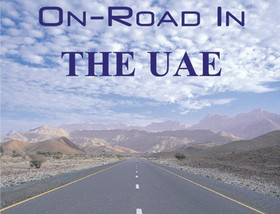
Gareth’s
book is a handy trip book in the UAE |
|
There was a dove on my doorstep
this morning.
It was still alive.
I herded cats, my cats,
They didn’t know what to do.
Nor did I.
They’re failing cats and pampered.
The dove was vermillion and lavender and grey
Beautiful and half dead.
I put it away from the cats on the back balcony all
day.
I told my son I would look after it, while he went
to school;
I shoo-ed him off to school.
I found the dove dead on my absent daughter’s
back balcony just now;
I threw the dove in the skip outside
and I didn’t tell my son.
18/1/2006
|
|
|
|
----------------------------------------------------------------------------------------------------------------------------
| The ENHG
Al Ain Chapter Newsletter…
February, 2006– Issue #232 |
The ENHG - AAESS Year-7
Hanging Gardens Geology Tour |
article &
photos by W. Moore |
| This year the ENHG has expanded its
program for school-aged youth taking 40-ish Al Ain
English speaking School year-sevens to the base
of the Hanging Gardens / Jebel Qatar hike on a geological
expedition (along with numerous teachers and parents
– thank you very much). “LET’S
ROCK N’ ROLL WITH WEATHERING” was an
opportunity for the students to get out of the classroom
and into nature, head-on. We were graced with cloudy
skies and gentle showers – a sure sign of
goodness. The three types of rock (can you |
|
 40-ish AAESS year-sevens
at the base of Jebel Qatar
40-ish AAESS year-sevens
at the base of Jebel Qatar |
|
|
name
them?) were identified and discussed, field sketches were
drafted, the causes of the various weathering patterns were
discussed with hands on sensitivity. Photos were taken. It
was a truly excellent adventure, Brien! Let’s do it
again!
|
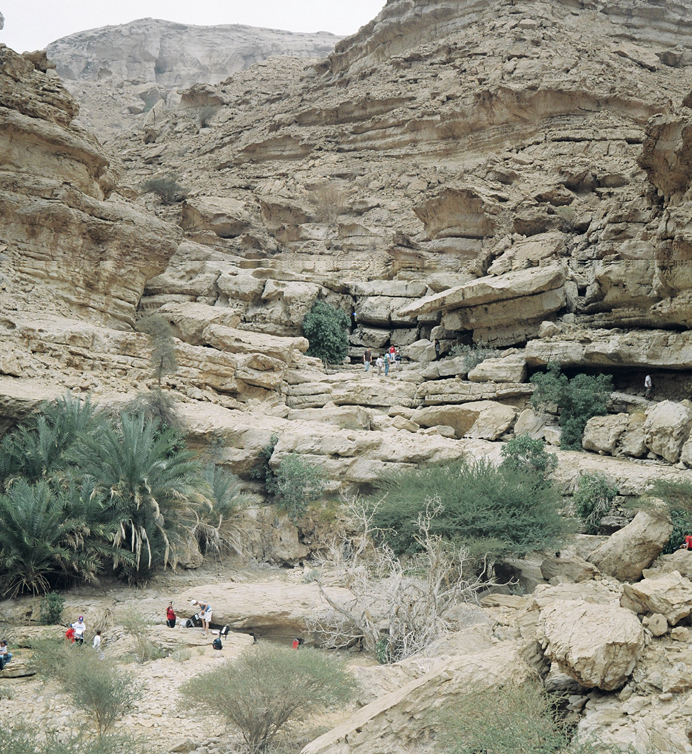
Can you find Juni?
|
|
|
----------------------------------------------------------------------------------------------------------------------------
| The ENHG
Al Ain Chapter Newsletter…
February, 2006– Issue #232 |
The
ENHG – Al Ain Chapter 1981 - |
Article
by Brien Holmes |
As reported by the Abu Dhabi
chapter of the ENHG in the March 1981 issue of their publication,
The Bulletin, “The Al Ain group formally became the
Al Ain Branch of the ENHG in 1980 but a regular liaison capacity
is still required between the two groups. The Al Ain Branch
has published its first Report and Proceedings (September
1980), a copy of which is in the library.”
The first few seasons were a little rough for the fledgling
group but the Al Ain chapter soon established a consistent
stride and the chapter has been moving from strength to strength,
due in large part to the population of expatriates at the
UAE University and, later, the two campuses of the Higher
Colleges of Technology, along with professionals from the
three local hospitals and various government and private sector
organizations. The Al Ain chapter is managed by a Committee
of volunteers; they meet on the first Tuesday of each month.
The chapter currently holds general meetings on the 2nd and
4th Tuesdays of each month (July, August and December excepted)
at the Al Ain Intercontinental Resort hotel. The group organizes
field trips that are normally held on Fridays each week. From
time to time, weekend field trips are held to destinations
including Ras al Khaimah and Nizwa. In all instances, the
group makes an effort to include all individuals, regardless
of age, physical condition or experience.
|
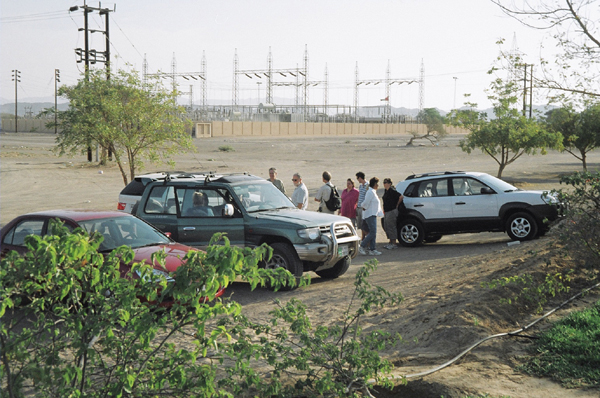 Folks gather in the
morning, then convoy out to the site of the week
photo by W.
Moore
Folks gather in the
morning, then convoy out to the site of the week
photo by W.
Moore |
| On its field trips, the chapter makes an
effort to contact local residents and has, in many instances,
established a relationship with local residents and farm
laborers. The group donates food and school materials
to a family in Ray (on the route between Mahdah and Hatta),
donated food and supplies to Obaid and Fatima Al Ka’abi
in Khutwah, and food and supplies to farmers in Jazirah.
(Regrettably, Obaid recently passed away and his sister
Fatima is now in the care of her daughter in nearby “new”
Khutwah.) At Musah, the group has been generously greeted
by Saif Al Ka’abi and his family; the chapter is
investigating ways to assist that community. When ever
possible, the group makes an effort to thank the local
residents for the opportunity to wander around their farms. |
|
|
|
----------------------------------------------------------------------------------------------------------------------------
| The ENHG
Al Ain Chapter Newsletter…
February, 2006– Issue #232 |
The ENHG –
Al Ain Chapter 1981 – cont…
|
During each season, additional
activities are organized for members with special interests.
For example, members interested in challenging mountain hiking
can join the events of the Ibrahim Zakhour Triple Crescent
Award. This program offers individuals an opportunity to climb
some of the more challenging peaks in the district. Each Saturday
evening the group holds a “curating” session as
the Al Ain chapter is the custodians of one of the largest
collections of insects for the UAE and northern Oman, much
of the collection donated by Mike Gillett. The group holds
regular trapping sessions using the generator and equipment
purchased by the chapter.
The group is proud of its modest efforts to subsidize research
for natural history topics. It has provided funds in support
of: DNA research on human remains found at archaeological
sites in the UAE; the study of the chemistry of camel brains;
a research study of dhubs; and the investigation of plant,
animal and insect life in a typical mountain oasis and wadi.
Individual members have contributed articles and photographs
for various publications of both the private and public sectors.
The chapter provides support and field guides, including
worksheets, for a variety of field trips arranged for students
of the Al Ain English Speaking School and the Gem School of
Dubai.
|
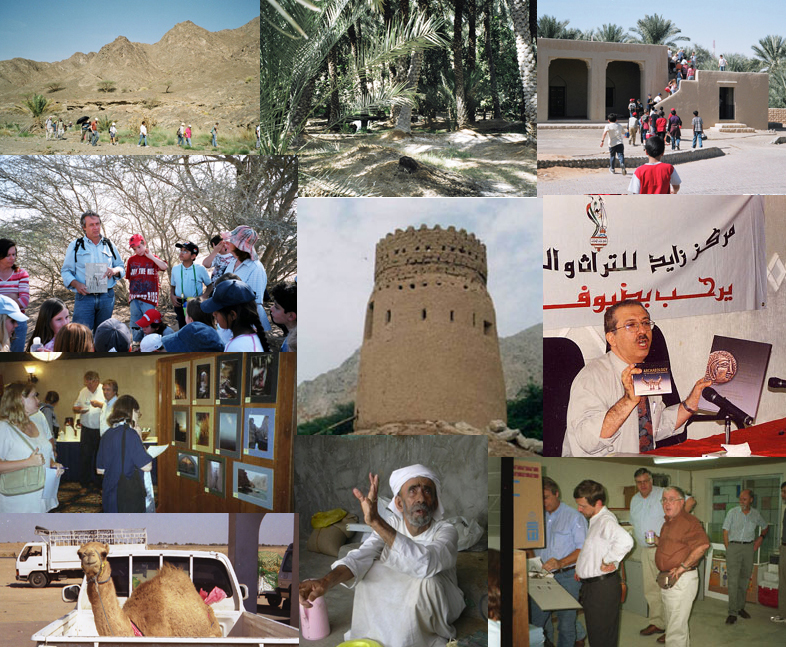
There is no way to show
it all, so here are just a few of the things we do
collage by W.
Moore |
|
|
----------------------------------------------------------------------------------------------------------------------------
| The ENHG
Al Ain Chapter Newsletter…
February, 2006– Issue #232 |
The
ENHG – Al Ain Chapter 1981 – cont… |
Annual events of the Al Ain chapter include
an Iftar Dinner (organized in cooperation with the Zayed Center
for Heritage and History), a photography competition, an Annual
General Meeting, and a celebration of the holiday season with
a Christmas Eve in the desert event. Members of the Al Ain
chapter also participate in the annual Inter Emirates Weekend,
sharing activities with colleagues from chapters in Abu Dhabi
and Dubai.
The group maintains a “work room” at a location
donated by the Al Ain English Speaking School. The chapter’s
assets, including computer, maps, generator and collections,
are kept in the space, along with the chapter’s modest
library of books, magazines, articles and videotape.
The Al Ain chapter has a variety of strategies to maintain
communication with members and report on its activities. The
traditional Newsletter has evolved from a paper publication
to an internet communication and remains the official publication
of the chapter. The group has an email discussion group, courtesy
of YahooGroups.com. The email service has been in place for
more than five years. The Al Ain chapter also maintains a
large website (www.enhg.org) with a collection of pages covering
all aspects of natural history. The site was originally established
as an archival site built around the articles and images published
in the Abu Dhabi chapter’s publication The Bulletin,
making these materials available to a wider audience since
the original publication is not widely available. Since its
inception, the website has become a source of information
including an internet history of field trips, documentation
of plants and insects, as well as information and links relevant
to the natural history of the UAE and Oman.
Of special interest to the group is the history of copper
smelting in the region over the past 5000 or more years. The
group has made an effort to record smelting sites and revisit
sites recorded in the past (ie Wadi Safafir). The search for
copper mine sites continues. Likewise, the group has a special
interest in the archaeology at Jabeeb where ancient falaj,
smelting hearths and occupation sites have been recorded.
These sites are under threat from development and the group
has worked in close cooperation with the Al Ain Museum to
identify sites and recommend their protection and preservation.
Other sites of special interest include the graves and settlements
of Jebel Qatarra and the Jebel Hafit period tombs of Jebel
Aqbar.
The Al Ain Museum is one of several “partners”
operating in conjunction with the Al Ain chapter. Other partners
include PIC (investment consultants), Emirates Environment
Group and the Al Ain English Speaking School, all of whom
collaborated to set up a waste collection station (metal and
paper). Other partners include the Zayed Center for Heritage
and History (part of UAE University), the Abu Dhabi Concert
Committee and the Al Ain Intercontinental Resort hotel.
For at least five years, the Al Ain chapter, working in cooperation
with the Abu Dhabi Concert Committee and the Al Ain Intercontinental
Resort, has organized field trips free of charge for the subscribers
of the annual Al Ain Classical Music weekend. At least seven
different field trips are organized for each Thursday and
Friday morning of these festival weekends.
The Al Ain chapter is working with the management of the
Mercure Hotel on Jebel Hafit to develop an interpretive nature
trail on the mountain.
The group will continue to evolve into the future, no doubt,
determined to maintain its spontaneity and to explore the
natural history of the UAE and northern Oman, finding new
and innovative ways to share their discoveries with individuals
and organizations around the world.
|
|
|
----------------------------------------------------------------------------------------------------------------------------
|






